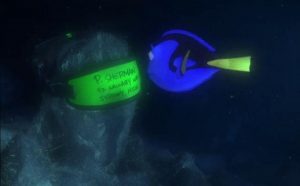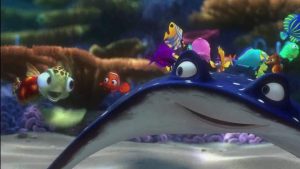37 Finding Nemo (2003)
Hope Below the Surface: Finding Nemo (2003)
By Christian Pool
Finding Nemo is an animated film by Pixar Animation Studios and published by Walt Disney Studios in 2003. It is the story of a clownfish named Marlin, who goes go on an underwater journey to find his missing son Nemo who has a bad fin that was injured when he was very young. Along his journey, Marlin encounters many obstacles usually in the form of different fish and with each encounter, Marlin learns something new and redefines the relationships that he has both with himself, his son, and his acquaintances that he meets along the way. I believe that when you take a deeper dive into the story and characters in Finding Nemo, you will find a rich and diverse world populated with a plethora of different characters. In my opinion, many of these characters represent different disabilities and personality profiles that we encounter in our real world. I believe that the way that these disabilities and defects are presented in a positive light has the ability to help all of us gain a better understanding of disabled individuals and can possibly even teach us a lesson on how to deal with these issues here in our real lives above water.
I will use different characters from the movie and an analysis of how they and their personal defects or disabilities are presented on the screen to support my belief that Finding Nemo goes beyond just being an animated children’s flick. It addresses many social issues that disabled individuals face every day and presents those individuals in a positive light that highlights their power to overcome obstacles, despite facing social stereotypes and preconceived notions about their roles in society. I will use different characters that we meet along both Marlin and Nemo’s journey and an analysis of their relationships to support my points about the film’s deeper implications. I will talk about different characters including Nemo and Gill, who both have similar physical disabilities in the form of a mutilated fin, Dory, Marlin’s companion who struggles with short-term memory loss, and of course Marlin himself who undergoes a journey of both self and social enlightenment as he comes to terms with his own anxiety and his relationships with the other fish he meets along his journey.

In the story for Finding Nemo, Nemo gets separated from his father on a school trip and ends up trapped in a fish tank in a dentist’s office quite a long way from his home and father. In the tank Nemo meets a very diverse group of fish from all different walks of life. However, one fish in particular relates to Nemo on a deeper level. Gill, a Moorish Idol fish voiced by Willem DaFoe, who also has an injured fin, teaches Nemo a lesson about his own value and about overcoming obstacles. The film presents Gill as dark and mysterious utilizing several camera and sound tricks to create an air of mystery about the fish, even the music and lighting is different the first few times we see Gill onscreen. Although Gill’s motivations could be presented as self-serving, in his plan to escape the tank and reunite Nemo with his father he teaches Nemo an important lesson about self-worth and helps Nemo shatter his own illusions about his value and abilities. He creates a plan to escape the tank that heavily relies on Nemo being able to overcome his perceptions about his disability, and he trains Nemo to be stronger and to realize that despite his disability he still has value. Nemo does eventually overcome the level of performance he sets for himself and helps the fish escape the tank.
I feel like Nemo and Gill’s relationship is very important to the central theme of the film. It shows both fish overcoming adversity and their relationship with their disabilities to complete the plan and escape from the tank. Up to this point in his life, Nemo has not really been told what he is capable of. His father was a very anxious and careful type and usually just reminded Nemo of what he couldn’t do. Gill sees Nemo’s value and understands Nemo’s struggle because of his similar affliction. Gill is presented in the film as the leader of the rag-tag gang of tank fish, and he uses his power and position to try to persuade Nemo to become more than he thinks he is and to become a valuable member both of the tank-gang and an asset to the escape plan.

Dory, a Pacific Regal Blue Tang voiced by the recognizable Ellen De-Generous, suffered from short-term memory loss since she was very young. Dory is easily one of the most recognizable and popular characters from the movie, and she did eventually become the central character in the sequel movie Finding Dory. Marlin comes across Dory very early in the film; right after he loses his son. When Dory finds out about Marlin’s predicament, she immediately offers to help, and as she starts to lead Marlin to his son it immediately becomes clear that there is something wrong. Marlin soon learns about Dory’s memory loss and before he manages to split up from Dory, they both get thrown into a string of events that drives the storyline forward and forces Marlin to get to know Dory better. Eventually, Marlin begins to recognize Dory’s value. By the end of the story, he even comments that without her he never would have completed his journey and found Nemo. However, along the way, Marlin does struggle with maintaining his relationship with Dory. He takes advantage of her affliction. However, at different points in the story, he also relies on Dory, and despite his doubts about her abilities and experience, she plays a big part in Marlin achieving his goal of finding his son.
There are a couple of key moments in Dory and Marlin’s relationship where Marlin is forced to confront his preconceived notions about Dory’s value. He even takes advantage of Dory’s affliction a few times in the story but when this ends up putting both Dory and himself in danger. After they survive the encounter with a little help from some sea turtles he vows never to do so again. Dory’s story is one of tragedy and overcoming adversity. The film does tap into Dory’s tragic past and the relationship with her parents that she cannot even remember, but mostly the film focuses on Dory’s value and on Marlin’s evolving relationship with Dory’s disorder. Many times in the film, Marlin doubts Dory’s ability to be an asset to his journey, but just as many times she overcomes his prejudice and saves the day. Even though Marlin sees dory as a burden at first she is the only fish that can read the address on the goggles he finds, so without her, he would not have known to go to Sydney to look for Nemo, and his journey could have ended right there. Later in the story when she helps Marlin catch a ride to Sydney inside a whale, he shows her some animosity and even aggression and resorts to demeaning her although his misgivings turn out to be wrong and Dory once again defies expectations and leads Marlin closer to his goal.
Through her relationship with Marlin, Dory learns that despite her memory loss she can still play an important part in Marlin’s journey and eventually is the one who finds Nemo. Through his relationship with Dory, Marlin must face some of his own insecurities and his preconceived notions about Dory’s value to his journey, as well as his expectations of what the disabled are capable of. In this realization, he also gains enlightenment about his relationship with his son and his relationship with himself, and his own anxiety. Although it is somewhat less highlighted in the film, I believe that Marlin also represents the struggle with anxiety and PTSD and how it can affect his relationship with himself and those close to him. Early in the film, Marlin experiences a tragic encounter that leaves its mark on him throughout the entire film. I found it very interesting how in the very first few minutes of the film Marlin is presented as adventurous and outgoing but after his tragic encounter Marlin’s personality changes. It is only a brief look that we get about what Marlin was like before the tragic episode that changed his life and character. I like the way that the film’s creators give us that glance, and throughout the entire film Marlin is constantly evolving himself through self-realization spurred on by his relationship with Dory and overcoming his preconceived notions about the other fish he meets along the way so that he can have a more positive relationship with the world around him and his own family and friends.

On the surface, Finding Nemo is a children’s film about fish and adventure but if you take a deeper dive into the underwater adventure I believe that hidden in the animated world in which Marlin and Nemo exist in there is an incredible dynamic to the characters and their relationships that the filmmakers encoded into the story. I remember watching the movie in theatres when I was very young and impressionable. I do not believe at the time that I consciously realized the many lessons and profoundness of the characters, their ailments, relationships, and ability to overcome adversity. However, I do believe that the movie had an impact on me. As an adult, upon reanalyzing the movie I feel that you can see the way they present the discrimination of disabled individuals as a socially created concept. By both realizing their own potential and breaking the preconceived notions of others, the characters demonstrate the power that these stereotypes can have and the power that each individual has to break their own misconceptions.
I hope that in a sea of Hollywood movies that may not be as eye-opening and enlightening, Finding Nemo can stand out as a beacon for the good that films can do as proponents for equality and ending the misconceptions that we may have about disabled individuals value, both socially and physically. I for one am glad that I had the opportunity to be exposed to positive influences both as an impressionable youth and in my adult life through film and media.
References
Millett, Ann. “Finding Nemo.” Disability Studies Quarterly, 2004, dsq-sds.org/article/view/873/1048.
Pixar Wiki, Fandom.com, pixar.fandom.com/wiki/Category:Finding_Nemo_Characters.
Benshoff, Harry M., and Sean Griffin. America on Film: Representing Race, Class, Gender, and Sexuality at the Movies. Wiley-Blackwell, 2011.
Vanderbilt University. “Films: Portrayals of People with Disabilities.” IRIS Center, 2020, iris.peabody.vanderbilt.edu/resources/films/.

